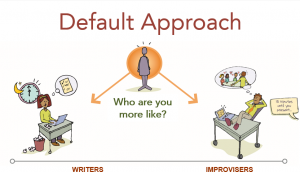
- Dale Ludwig Meetings, Presentations, Subject Matter Experts
One of the benefits of defining business presentations as Orderly Conversations® is that we can guide learners’ improvement based on their individual responses to the tensions involved. Fundamentally, this tension is between what’s required to make a presentation an orderly process and what makes it a spontaneous interaction. Let’s break that down.
Presentations Require Order
One of the goals of every presenter is to make the process as efficient and clear as possible. That requires preparation in advance and a sense of structure as the presentation is delivered. This sense of structure is defined by listeners, not by the presenter. That is, you may feel perfectly well-organized and “orderly,” but if your audience doesn’t sense it, your perception doesn’t count.
… you may feel perfectly well-organized and “orderly,” but if your audience doesn’t sense it, your perception doesn’t count.
Presentations Are Conversations
While the sense of order is crucial for a successful presentation, listeners must also feel that they are engaged in a conversation with the presenter. If they don’t feel this, it may be because the presenter is overly-scripted, inflexible, or ignoring them. While listeners crave an orderly process, they also expect a spontaneous interaction will take place.
What this means is that presenters must find the right balance between these opposing goals:
- Having a plan vs. being spontaneous
- Being efficient vs. being flexible
- Controlling the discussion vs. encouraging it
Understanding this is important in terms of what listeners expect during a presentation. It’s also crucial to understand that presenters themselves have a gut response to the tension between the order and the conversation.
Presenters Have Preferences and They Matter
We call a presenter’s response to the tensions involved in an Orderly Conversation a Default Approach. Your Default may be the result of your habits and preferences. It may be a reaction to a great success or failure you’ve had presenting in the past. Regardless of where it came from, it’s important to assess and adapt to it.
Here are the strengths and weaknesses of the two fundamental Defaults.
| Some people are Writers because they are comfortable with the orderly aspects of presenting. They rely on preparation for their success, and are naturally comfortable with the work that takes place prior to delivery. Slide creation, accuracy of information, and analysis are second nature to them. The downside for Writers, though, is they can be too strict during delivery and appear inflexible to their listeners. Some writers are perfectionists and discourage interruptions as they present. | On the other side of the Default spectrum are Improvisers. These presenters thrive with the connection they make with listeners during their presentations. They are naturally engaging and listener-focused. The downside for them is that they sometimes delay or underestimate the need for preparation. This can lead to wandering, unfocused delivery, poorly prepared slides, and too many detours, which leads to time management issues. |
Most people are a combination of both Writer and Improviser, but they each have a particular comfort zone they default to, especially under pressure. For most people, adapting to your Default Approach requires applying skills and changes in behavior that feel uncomfortable, sometimes unnatural. Recognizing and accepting the need for these adjustments is an important part of the improvement process.


